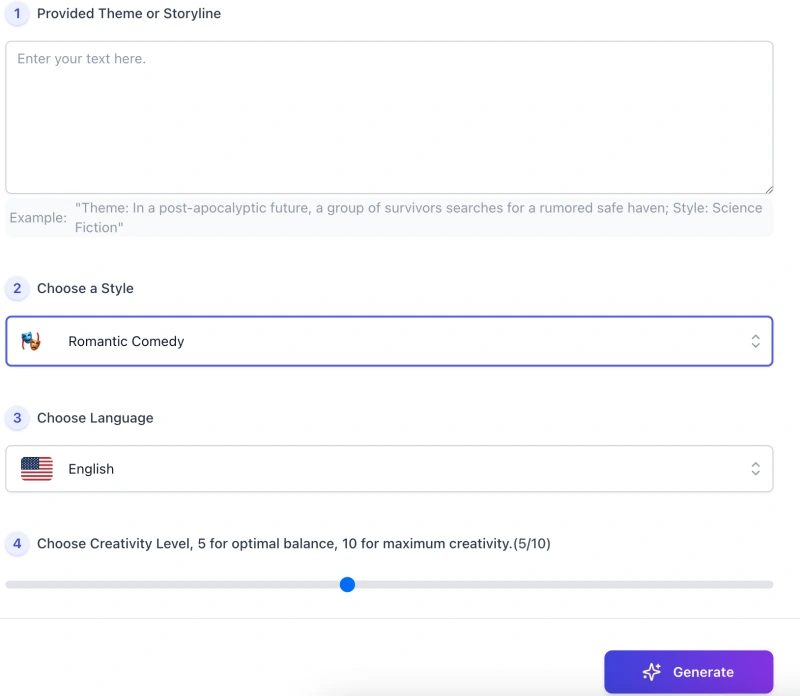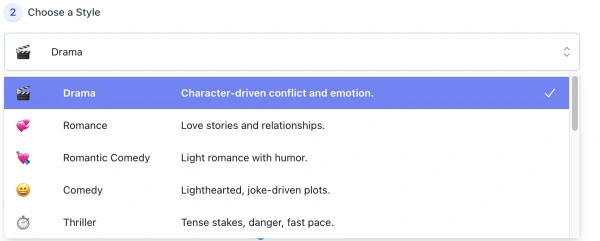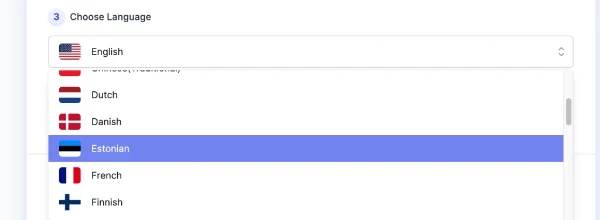This is AIFreeBox AI Movie Generator page – an online assistant for screenwriters, filmmakers, students, and creative storytellers. It helps you quickly turn a simple idea into a structured movie concept — complete with a logline, characters, three-act outline, and a fitting ending.
This page introduces the tool’s capabilities, ideal use cases, step-by-step guide, writing tips, known limitations, troubleshooting advice, and FAQs — giving you a complete reference for shaping movie ideas with confidence.
What Can AIFreeBox AI Movie Generator Do?
The AIFreeBox AI Movie Generator is powered by transformer-based language models fine-tuned for storytelling. It is not a generic text generator, but a creative companion that helps turn a single idea into a structured movie concept.
With genre presets (Thriller, Romantic Comedy, Fantasy, etc.), the tool ensures each plot follows audience expectations and cinematic conventions. Every result comes in a clear framework — Title, Logline, Characters, Setting, Synopsis, Three-Act Outline, Ending, and optional Sequel Hook — ready for editing or use in scripts, pitches, or study.
Its value lies in speeding up the idea stage: from breaking writer’s block to shaping pitch decks or classroom projects. It supports 14 genres and 33 languages, balancing creative freedom with reliable structure.
In a human-AI workflow, the AI expands the seed into a cinematic outline, while the user refines details, adjusts characters, and reshapes endings — ensuring the final story remains personal and original.
🎭 AIFreeBox Movie Generator vs. Generic Text Generators
Not all AI tools are made for movies — here’s how this one stands apart:
| 📌 Dimension |
🎬 AI Movie Generator |
📝 Generic Text Generator |
| 🎯 Focus |
Built for movie ideas and story outlines |
General text, no cinematic structure |
| 📚 Structure |
Fixed modules: Movie Title, Logline, Characters, Three-Act |
Unstructured paragraphs, user must organize |
| 🧭 Genre |
14 presets (Thriller, Romance, Fantasy, etc.) |
No genre awareness |
| 🌍 Language |
33 languages with consistent formatting |
Basic translation, uneven tone |
| 🤝 Collaboration |
AI expands ideas → user refines |
User must rewrite to fit story form |
| ⚡ Efficiency |
Fast concept drafts for pitches or study |
Time lost reshaping raw text |
🌟 Recommend Scenarios and Benefits
If you’re looking for inspiration or structure at the start of storytelling, here are the key reasons this tool is worth using:
| 💡 Scenario |
🎯 Pain Point Solved |
👥 Who Benefits |
| 🚀 Kickstarting a script |
Breaks through writer’s block with quick loglines and outlines |
Screenwriters & script students |
| 📑 Pitching a project |
Provides structured drafts for proposals or pitch decks |
Directors, producers, indie creators |
| 🎓 Learning storytelling |
Shows how genres shape story beats and arcs |
Film & literature students, educators |
| 🎥 Short film planning |
Transforms raw ideas into usable short-film storyboards |
Independent filmmakers |
| 🌍 Multilingual creation |
Generates plots in 33 languages with consistent structure |
Global creators, translators |
| 🧩 Exploring genres |
Tests ideas across 14 preset genres for creative variety |
Writers seeking fresh angles |
| 🕒 Saving development time |
Reduces hours of brainstorming into minutes |
Busy professionals & hobbyists |
📖 How to Make a Movie Idea with AIFreeBox AI:
Step-by-Step Guide

Step 1. Provide a Theme or Storyline
Enter your idea in the text box. It can be a simple theme, a short sentence, or a rough storyline seed. The tool will expand it into a structured movie outline.
Step 2. Choose a Style (Genre Preset)

Select one genre from the list (e.g., Thriller, Romantic Comedy, Fantasy). Each preset follows genre conventions to ensure the story feels authentic and consistent.
Step 3. Choose a Language

Pick the output language. The tool supports 33 languages, and all sections of the result (titles, loglines, outlines) will appear in the language you choose.
Step 4. Adjust Creativity Level
Move the slider to set creativity.
– 5 = balanced, structured results
– 10 = highly imaginative, more experimental
Choose the level that matches your project’s needs.
Step 5. Generate Your Movie Concept
Click Generate and wait a moment. The system will deliver a structured result including Title, Logline, Characters, Setting, Synopsis, Three-Act Outline, Ending, and an optional Sequel Hook.
Step 6. Download or Copy the Result
You can save the output directly with the Download button or copy it to your clipboard with Copy, ready to paste into your notes, scripts, or pitch documents.
Step 7. Report a Bug and Feedback (Real Human Support)

If something doesn’t work as expected, click Report Bug. This goes directly to our support team — real people are available to review your issue and respond quickly. We value your experience and treat every report seriously.
By following these steps, you can turn a single idea into a movie “blueprint” — complete with structured synopsis, characters, and three-act framework. The AI provides the cinematic outline, while you refine the details, adjust the tone, and shape the final story to match your own creative vision.
🎬 Pro Tips to Shape Stronger Movie Ideas
From a working screenwriter’s POV: tools don’t write films—your choices do. Use these pointers to steer the generator without losing your voice.
✅ Get the Draft You Actually Imagined
- 📝 Be specific with your seed — swap “a love story” for “two rival chefs in Paris forced to co-run one kitchen.”
- 🎭 Pick the right genre preset — Thriller, Romantic Comedy, Fantasy, etc.; presets keep beats and pacing on-genre.
- 🧭 Give a clear goal + obstacle — “win the contest, but the partner is a sworn rival.”
- 🎚️ Tune creativity with intent — 5 = tighter, industry-ready; 10 = bold, surprising. Test 2–3 settings.
- 🔁 Iterate fast — nudge the seed, switch genre once, regenerate; compare versions side by side.
- 🌍 Lock your language — choose one of the 33 languages so titles, loglines, and acts stay consistent.
✨ Make It Yours: Personalize & Level Up
- 🔍 Screen like an editor — keep the version with the cleanest premise and stakes; archive the rest for beats or B-plots.
- ✏️ Rename and reshape — adjust character wants/flaws, tighten setting, sharpen the central conflict.
- 🎯 Own the ending — choose a twist or a genre-faithful resolution that supports your theme.
- 🧩 Add layers — backstory, subplots, cultural context; weave them into Act II to deepen payoff.
- 🛠️ Use the structure as scaffolding — Title → Logline → Characters → Setting → Synopsis → Three Acts → Ending → (Optional) Sequel Hook.
- 🤝 Treat AI as a co-writer — let it draft the blueprint; you refine tone, rhythm, and scene logic to keep authorship.
Bottom line: the generator builds a cinematic blueprint (logline, roles, three-act spine) aligned with genre conventions; you select, revise, and rewrite to protect originality and personal style.
🎯 User Case Study: From Idea to Cinematic Blueprint
Realistic examples show how creators use the AI Movie Generator to transform a seed idea into a structured draft—and how human refinement turns it into a unique story.
Case 1 — Pitch-Ready Heist Concept
🧩 User Input
- Theme: A retired thief is forced to assemble one last crew for an impossible museum heist.
- Genre: Crime/Heist
- Language: English
🤖 AI Draft Output (Shortened)
- Title: The Last Quiet Job
- Logline: A reformed thief recruits an uneasy crew to steal a priceless relic, only to find the head of security is his estranged daughter.
- Three-Act Outline:
- Act I: Forced out of retirement · Crew assembled · Plan designed.
- Act II: Rival interference · Midpoint reveal: daughter is security lead · Crew fractures.
- Act III: The heist unfolds · Betrayal inside the team · Emotional showdown between father and daughter.
✍️ User Refinement
- Adjusted daughter’s role: risk analyst instead of security chief, making conflict more nuanced.
- Sharpened setting: museum gala night, time pressure heightened.
- Ending choice: kept grounded—father deliberately trips alarm to save the crew.
Result: A tighter, pitch-friendly outline that balances AI structure with human creative direction.
Case 2 — Student Short Film Concept
🧩 User Input
- Theme: A shy high school senior must perform a solo at graduation to secure her exchange program spot.
- Genre: Coming of Age
- Language: English
🤖 AI Draft Output (Shortened)
- Title: Beyond the Spotlight
- Logline: An introverted girl confronts her stage fright and her family’s doubts when a solo performance decides her future.
- Three-Act Outline:
- Act I: Learns of exchange program · Teacher pushes for solo · Family discourages risk.
- Act II: Attempts rehearsals · Public failure · Finds her unique voice with peer support.
- Act III: Power outage at graduation · Performs by candlelight · Earns both acceptance and independence.
✍️ User Refinement
- Expanded family subplot: added a scene about career vs. passion, highlighting generational conflict.
- Adjusted Act II: included a peer band rehearsal scene to show growth through collaboration.
- Ending refinement: shifted from “success = acceptance” to “success = self-confidence,” making the resolution more authentic.
Result: A short-film-ready outline with emotional depth and a personal creative signature.
These case studies show the real value of human-AI collaboration: the generator builds the cinematic blueprint (logline, roles, three-act arc), while the user decides, edits, and reshapes the draft into a story that feels original and true.
🎨 Style System Overview
Each style is like a “lens” — it shapes how the same idea feels on screen. Here’s a quick look at the options in plain language.
- 🎭 Romantic Comedy — Lighthearted love stories with humor and charm.
- 🚀 Science Fiction — Futuristic worlds, technology, and big “what if” ideas.
- 🔪 Thriller — Tense, suspenseful plots with danger and high stakes.
- 😂 Dark Humor — Comedy with a sharp or tragic twist.
- ⚔️ Action Adventure — Quests, battles, and journeys full of energy.
- 🧙 Fantasy — Magical settings, mythical beings, and epic quests.
- 📜 Historical — Stories rooted in real eras, figures, and events.
- 🌱 Coming of Age — Youth, growth, and finding identity.
- 🎨 Animation — Colorful, imaginative worlds fit for all ages.
- 🎶 Musical — Stories told with songs, rhythm, and performance.
Tip: Choose the style that matches your vision. The same idea can feel playful, tense, or magical depending on the lens you pick.
⚠️ Limitations & Troubleshooting
Every tool has limits. Here are the main issues you might face with the AI Movie Generator — and how to handle them.
| ⚠️ Limitation |
🔍 What You Might See |
💡 Suggested Solution |
| Generic or cliché output |
Plots feel predictable or flat |
Refine your input with more detail or context |
| Genre mismatch |
Story doesn’t feel aligned with chosen preset |
Re-check genre choice; regenerate with adjusted seed |
| Language inconsistency |
Mix of English with target language |
Set language clearly; regenerate to enforce consistency |
| Overly long results |
Excessive detail, hard to skim |
Use shorter input; trim output manually after generation |
| Lack of originality |
Feels too close to existing movies |
Add unique twists (new setting, character flaw, conflict) |
| Unclear character roles |
Protagonist/antagonist not well defined |
Adjust in refinement stage; clarify roles in your input |
| Technical issues |
Button not working or output error |
Click Report Bug — our support team responds directly |
❓ FAQs
1. Can this tool write a full screenplay?
No. The AI Movie Generator creates structured concepts — loglines, characters, and a three-act outline. A full script still requires human writing and creative decisions.
2. How accurate are the genre presets?
Presets follow common genre conventions, but results may vary. Use them as a starting point, then refine the draft to match your specific vision.
3. Will the output be 100% original?
The AI generates unique drafts each time, but originality depends on your input and refinements. For truly distinctive stories, add your own twists and personal details.
4. Can I use the generated ideas commercially?
Yes, but treat outputs as drafts or inspiration. Final work should include your own creative input to ensure authenticity and avoid overlap with existing works.
5. Does the tool save or share my inputs?
No. Your input and output are not used for public display and are not saved for others to view. Your creative ideas remain private.
6. What if the result feels too generic or cliché?
Try adding more context in your input, adjust the creativity level, or regenerate in a different genre. Human refinement is key to making it unique.
7. What languages does it support?
The tool supports 33 languages. Headings, loglines, and outlines will appear in the language you choose, though occasional mixing may require light editing.
8. What should I do if the tool doesn’t work as expected?
Click Report Bug in the interface. Our support team — real people — will review the issue and get back to you quickly.
✍️ Creator’s Note
The AI Movie Generator was built with one idea in mind: to give creators a starting point, not a finished product. It can help break through a block, suggest a structure, or offer a different angle — but the story is always yours to tell.
Think of the AI as a collaborator who drafts a blueprint: a logline, characters, and a three-act arc. You decide what stays, what changes, and how the ending truly lands. The value lies in the exchange — the speed and structure of the AI, combined with the intent and imagination of the human writer.
Every film begins with a spark. This tool is here to help you capture that spark and shape it into something you can build on. The voice, the choices, and the authorship remain yours.
— Matt Liu
2025-10-20
🎬 Start shaping your next movie idea — generate a fresh concept now.
Free, online, and always ready to spark new stories, characters, and cinematic worlds.



